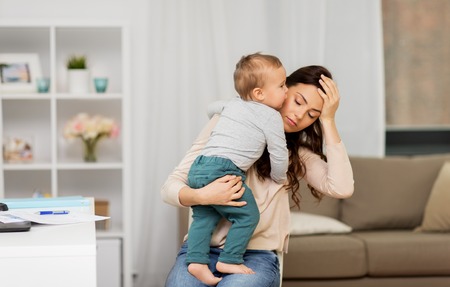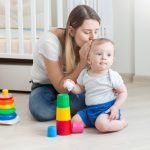1. Recognizing the Symptoms of Seasonal Allergies in Babies
As a parent, it can be tough to tell whether your baby has a seasonal allergy or just a common cold. Since babies can’t express how they feel, recognizing the signs early can help you provide relief and decide if medical attention is needed.
Common Signs of Seasonal Allergies in Babies
Seasonal allergies, also known as hay fever or allergic rhinitis, occur when your baby’s immune system reacts to pollen, mold spores, or other airborne allergens. Here are some typical symptoms:
| Symptom | Description |
|---|---|
| Sneezing | Frequent sneezing without signs of a cold. |
| Watery or Itchy Eyes | Tears up often, eyes may appear red or irritated. |
| Nasal Congestion | A stuffy nose that lasts for weeks with no fever. |
| Runny Nose (Clear Mucus) | A continuous runny nose with clear mucus instead of thick yellow or green mucus seen in colds. |
| Coughing | A dry cough that persists, especially outdoors. |
| Irritability & Trouble Sleeping | Your baby may be fussier than usual due to discomfort from congestion and itchiness. |
| No Fever | This is a key difference between allergies and colds—seasonal allergies do not cause fever. |
Differentiating Between Allergies and Colds
The symptoms of seasonal allergies and colds can overlap, making it tricky to determine what’s bothering your baby. Here’s a quick comparison:
| Seasonal Allergies | Common Cold | |
|---|---|---|
| Mucus Color | Clear and watery | Thick, yellow, or green |
| Sneezing | Frequent and ongoing | Lesser and temporary |
| Coughing | Drier cough, often worse outdoors | Might be wet with phlegm due to postnasal drip |
| Nasal Congestion Duration | Persistent for weeks or months during allergy season | A few days to a week and improves over time |
| Puffy or Watery Eyes | Common with redness and itching | Lesser chance unless caused by irritation from rubbing eyes too much |
| Presents with Fever? | No fever present with allergies. | A mild fever is common with colds. |
| Sensitivity to Environment? | Sneezing and congestion worsen outdoors, especially on high-pollen days. | No direct link to environmental exposure. |
When to See a Doctor?
If your baby’s symptoms last longer than two weeks, seem to worsen when exposed to outdoor allergens like pollen, or interfere with sleep and feeding, its best to consult a pediatrician. They can help rule out infections and discuss possible allergy management options.
The next step is learning how to help ease your babys discomfort from seasonal allergies. Stay tuned for practical tips on reducing allergens and soothing symptoms!
2. Common Triggers of Seasonal Allergies
Understanding what triggers your baby’s seasonal allergies can help you take steps to minimize exposure and ease their symptoms. Some of the most common allergens include pollen, mold, and dust, which vary by season.
Pollen
Pollen is one of the most common seasonal allergy triggers. It comes from trees, grass, and weeds, and its presence in the air changes depending on the time of year.
| Season | Main Pollen Sources |
|---|---|
| Spring | Trees (oak, maple, birch) |
| Summer | Grass (Bermuda, Timothy, Kentucky bluegrass) |
| Fall | Weeds (ragweed, sagebrush, pigweed) |
| Winter | Pollen levels are generally lower, but indoor allergens like mold and dust may be more problematic. |
Mold
Mold spores thrive in damp environments and can be found both indoors and outdoors. During warmer months, outdoor mold grows on fallen leaves and soil, while indoor mold is more common in bathrooms and basements during colder months.
Dust and Dust Mites
Dust mites are tiny creatures that live in household dust. They can trigger allergy symptoms year-round but may become worse in winter when homes are closed up for warmth. Frequent cleaning and using allergen-proof covers on bedding can help reduce exposure.
How Different Seasons Affect Allergy Symptoms in Babies
The severity of seasonal allergies can change depending on the weather and environment. Here’s how different seasons impact allergy symptoms:
- Spring: High tree pollen levels can lead to sneezing, runny nose, and itchy eyes.
- Summer: Grass pollen is at its peak, making outdoor playtime challenging for sensitive babies.
- Fall: Ragweed pollen is a major trigger, along with mold from fallen leaves.
- Winter: Indoor allergens like dust mites and mold become more prominent due to closed windows and heating systems.
If you notice your baby showing allergy symptoms during certain times of the year, identifying potential triggers can help you take steps to manage their exposure.
![]()
3. When to See a Pediatrician
Its normal for babies to experience mild seasonal allergy symptoms, but if their condition worsens or starts interfering with daily activities and sleep, it may be time to consult a pediatrician. Knowing when to seek medical advice can help ensure your baby gets the right care.
Signs That Require Medical Attention
If you notice any of the following signs, its best to schedule an appointment with your babys doctor:
| Symptom | Why It’s a Concern |
|---|---|
| Severe congestion or difficulty breathing | This could indicate something more serious than allergies, such as a respiratory infection. |
| Persistent or worsening symptoms | If symptoms last for weeks despite home remedies, medical treatment may be needed. |
| Trouble sleeping or feeding due to discomfort | Poor sleep and reduced appetite can affect your babys growth and well-being. |
| Frequent ear infections | Allergies can cause fluid buildup in the ears, leading to infections. |
| A persistent cough or wheezing | This could be a sign of asthma triggered by allergies. |
What to Expect at the Doctor’s Visit
Your pediatrician will likely ask about your baby’s symptoms, how long they’ve lasted, and any potential triggers. They might recommend allergy testing or prescribe medications like antihistamines if necessary. In some cases, they may refer you to an allergist for further evaluation.
Questions to Prepare For
- When did you first notice the symptoms?
- Do they occur at certain times of the year?
- Are there any known family allergies?
- Have you tried any home remedies, and did they help?
The Importance of Early Intervention
If left untreated, seasonal allergies can lead to complications like chronic sinus infections or asthma. Seeking medical advice early can help manage your babys discomfort and improve their quality of life.
4. Managing Allergies at Home
When your baby has seasonal allergies, making small changes at home can help reduce their exposure to allergens and ease their symptoms. Here are some practical ways to create an allergy-friendly environment.
Use an Air Purifier
An air purifier with a HEPA filter can help remove pollen, dust, and other airborne allergens from your home. Place one in your babys nursery and other frequently used rooms to improve air quality.
Keep Windows Closed
During peak pollen seasons, its best to keep windows shut, especially in the morning when pollen counts are highest. Use air conditioning instead of opening windows for ventilation.
Maintain a Clean Home Environment
Regular cleaning helps minimize allergens inside your home. Focus on areas where pollen and dust can accumulate, such as carpets, bedding, and furniture.
| Cleaning Task | How Often |
|---|---|
| Wash baby’s bedding | Once a week in hot water |
| Vacuum carpets and rugs | At least twice a week using a HEPA-filter vacuum |
| Dust surfaces | Every few days with a damp cloth |
| Bathe your baby after outdoor play | Daily during allergy season |
Avoid Tracking Pollen Indoors
Pollen can easily enter your home on clothing, shoes, and even pets. To minimize exposure:
- Change clothes immediately after coming inside.
- Leave shoes at the door.
- Wipe pets down with a damp cloth if they’ve been outside.
Laundry Tips for Allergy Season
Pollen can cling to fabric, so washing clothes properly is essential.
- Avoid drying clothes outside; use a dryer instead.
- Add an extra rinse cycle to remove any lingering allergens.
- If possible, use hypoallergenic detergent to prevent skin irritation.
Create a Safe Sleep Environment
Your baby spends a lot of time sleeping, so their crib should be as allergen-free as possible:
- Use allergen-proof mattress and pillow covers.
- Avoid stuffed animals that collect dust—wash them regularly if needed.
- Keeps pets out of the nursery to reduce dander exposure.
Making these simple adjustments can make a big difference in keeping your baby comfortable during allergy season. By reducing allergens in your home, you can help ease their symptoms and create a safer space for them to rest and play.
5. Safe Treatment Options for Babies
When your little one is dealing with seasonal allergies, its important to find safe and gentle ways to ease their symptoms. Since babies have delicate immune systems, always opt for baby-friendly treatments and consult a pediatrician if symptoms persist.
Saline Sprays and Nasal Suction
Saline sprays can help clear out allergens from your babys nasal passages, making it easier for them to breathe. Pairing a saline spray with a gentle nasal suction bulb or an aspirator can remove excess mucus and reduce congestion.
Using a Cool Mist Humidifier
A cool mist humidifier adds moisture to the air, which can help soothe irritated nasal passages and prevent dryness. Be sure to clean the humidifier regularly to prevent mold or bacteria buildup.
Keeping Allergens Away
Minimizing allergen exposure is key to reducing symptoms. Here are some simple ways to keep allergens under control:
| Allergen Source | How to Reduce Exposure |
|---|---|
| Pollen | Keep windows closed during high pollen seasons and wipe down your baby’s hands and face after being outside. |
| Dust Mites | Wash bedding in hot water weekly and use hypoallergenic mattress covers. |
| Pet Dander | Bathe pets regularly and keep them out of your baby’s sleeping area. |
| Mold | Use a dehumidifier in damp areas and clean frequently with mold-resistant products. |
When to Consider Allergy Medications
If your babys allergy symptoms are persistent or severe, talk to your pediatrician about safe medication options. Some antihistamines may be suitable for infants, but only under medical supervision. Never give over-the-counter allergy medications without consulting a doctor first.
The Importance of Consulting a Doctor
If home remedies aren’t providing relief or if symptoms worsen, it’s essential to seek medical advice. Your pediatrician can help determine whether your baby’s symptoms are truly allergies or another condition requiring different treatment.

